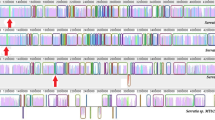Abstract
A putative ochratoxin A (OTA) biosynthetic gene cluster inP. nordicum has been identified. The first part of the gene cluster is located on a DNA fragment of 10 kb in length and harbours three genes. A gene with high homology to an alkaline serine protease gene (accession number AY557343), which represents the upstream border of the cluster. Furthermore the fragment carries a large part (about 2 kb) of the 5′ end of a polyketide synthase (otapksPN, accession number AY196315) and a complete non-ribosomal peptide synthetase (otanpsPN, accession number AY534879). The second part of the cluster is located on a 4.3 kb fragment that harbours three open reading frames (ORFs) encoding putative OTA biosynthetic proteins: one incomplete ORF at the 5′ end of the fragment demonstrated homology to an organic anion transporter from rat kidneys (otatraPN). This transporter has been described to be responsible for the transport of toxic OTA out of the cell. One complete ORF of 951 nucleotides is also located on this fragment. This gene has limited homology to a chloroperoxidase fromGluconobacter oxidans. At the 3′ end of this DNA fragment is an incomplete open reading frame of a potential nitrate transporter. The transcription of all putative OTA biosynthetic genes is increased under OTA conducive conditions. The expression kinetics of the genes resembles that of secondary metabolite biosynthetic genes, in which these genes are co-ordinately expressed during the late growth phase.
PCR analysis demonstrated that the gene cluster is only present in the two ochratoxin A producingPenicillium species,P. verrucosum andP. nordicum. P. nalgiovense, a species occurring in the same habitat asP. nordicum carries inactive homologues of the genes. All other species proved to be negative for the genes. This was also true for OTA producing Aspergilli.
Similar content being viewed by others
References
Sage M, Krivobok S, Delbos E, Seigle-Murandi F, Creppy EE (2002) Fungal flora and ochratoxin A production in grapes and musts from France. J Agric Food Chem 50: 1306–1311
Thirumala-Devi K, Mayo MA, Reddy G, Emmanuel KE, Larondelle Y, Reddy DVR (2001) Occurrence of ochratoxin A in black pepper, coriander, ginger and turmeric in India. Food Addit Contam 18: 830–835
Joosten HMLJ, Goetz J, Pittet A, Schellenberg M, Bucheli P (2001) Production of ochratoxin A byAspergillus carbonarius on coffee cherries. Int J Food Microbiol 65: 39–44
Larsen TO, Svendsen A, Smedsgaard J (2001) Biochemical characterization of ochratoxin A-producing strains of the genus Penicillium. Appl Environ Microbiol 67: 3630–3635
Lund F, Frisvad JC (2003)Penicillium verrucosum in wheat and barley indicates presence of ochratoxin A. J Appl Microbiol 95: 1117–1123
Bogs C, Battilani P, Geisen R (2006) Development of a molecular detection and differentiation system for ochratoxin A producingPenicillium species and its application to analyse the occurrence ofP. nordicum in cured meats. Int J Food Microbiol 107: 39–47
O'Callaghan J, Caddick MX, Dobson ADW (2003) A polyketide synthase gene required for ochratoxin A biosynthesis inAspergillus ochraceus. Microbiology 149: 3485–3491
Karolewiez A, Geisen R (2005) Cloning a part of the ochratoxin A biosynthetic gene cluster ofPenicillium nordicum and characterization of the ochratoxin polyketide synthase gene. System Appl Microbiol 28: 588–595
Geisen R (2004) Molecular monitoring of environmental conditions influencing the induction of ochratoxin A biosynthetic genes inPenicillium nordicum. Mol Nutr Food Res 48: 532–540
Färber P, Geisen R (2004) Analysis of differentially-expressed ochratoxin A biosynthesis genes ofPenicillium nordicum. European J Plant Pathol 110: 661–669
Sambrook J, Russel DW (2001) Molecular Cloning. 3, Cold Spring Harbour Laboratory Press, New York
Noé B, Hagenbuch B, Stieger B, Meier PJ (1997) Isolation of a multispecific organic anion and cardiac glycoside transporter from rat brain. Proc Natl Acad Sci USA 94: 10346–10350
Walton JD (2000) Horizontal gene transfer and the evolution of secondary metabolite gene clusters in fungi: an hypothesis. Fungal Genet Biol 30, 167–171
Ehrlich KC, Yu J, Cotty PJ (2005) Aflatoxin biosynthesis gene clusters and flanking regions. J Appl Microbiol 99: 518–527
Simons BH, Barnett P, Vollenbroek EGM, Dekker HL, Muijsers AO, Messerschmidt A, Wever R (1995) Primary structure and characterization of the vanadium chloroperoxidase from the fungusCurvularia inaegualis. Eur J Biochem 229: 566–574
Shimizu T, Kinoshita H, Ishihara S, Sakai K, Nagai S, Nihira T (2005) Polyketide synthase gene responsible for citrinin biosynthesis inMonascus purpureus. Appl Environ Microbiol 71: 3453–3457
Höhler D (1998) Ochratoxin A in food and feed: occurence, legislation and mode of action. Z Ernährungswiss 37: 2–12
Stergiopoulos I, Zwiers LH, De Waard MA (2002) Secretion of natural and synthetic toxic compounds from filamentous fungi by membrane transporters of the ATP-binding cassette and major facilitator superfamily. Eur J Plant Pathol 108: 719–734
Author information
Authors and Affiliations
Corresponding author
Additional information
Financial support: EU project “Development of cost-effective control and prevention strategies for emerging and future foodborne pathogenic microorganisms throughout the food chain”, FOOD-CT-2005-07081
Rights and permissions
About this article
Cite this article
Geisen, R., Schmidt-Heydt, M. & Karolewiez, A. A gene cluster of the ochratoxin A biosynthetic genes inPenicillium . Mycotox Res 22, 134–141 (2006). https://doi.org/10.1007/BF02956777
Issue Date:
DOI: https://doi.org/10.1007/BF02956777




